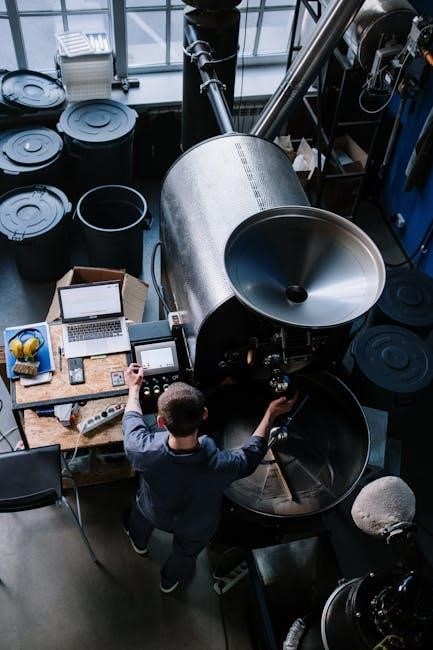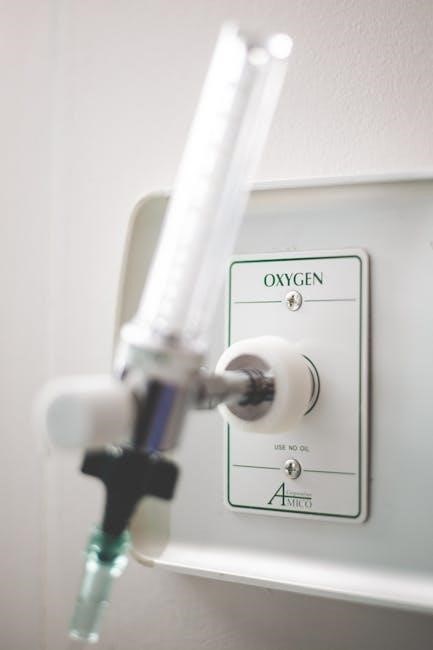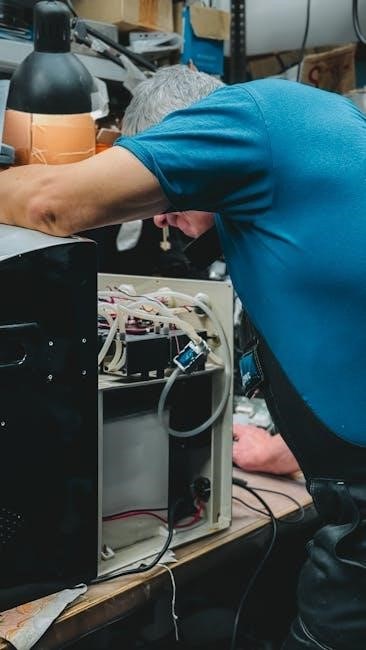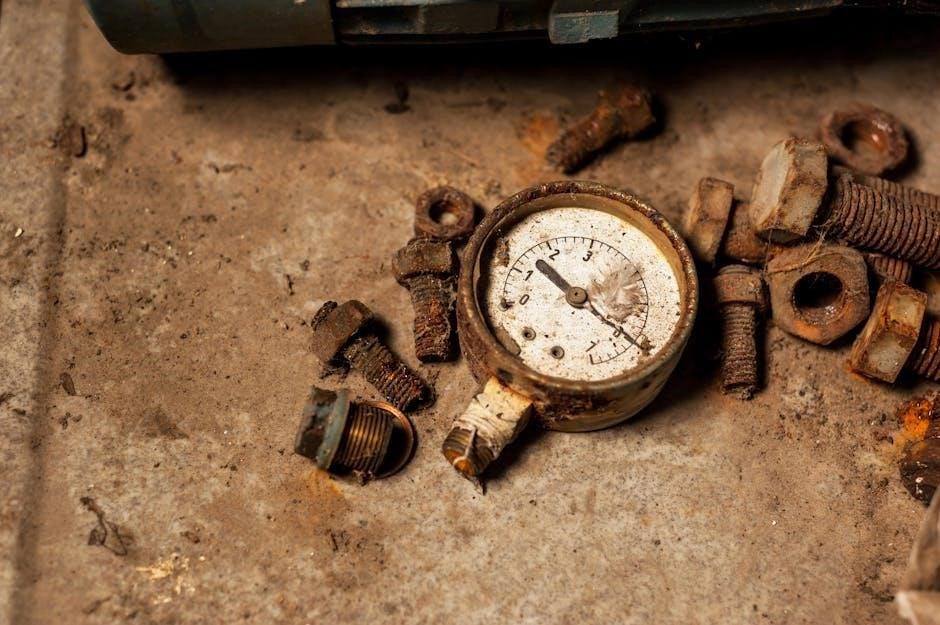manual air valve
Manual air valves are essential components used to control airflow in various systems‚ ensuring proper pressure and flow regulation. They are simple‚ durable‚ and cost-effective solutions for managing pneumatic operations across industries.

Types of Manual Air Valves
Manual air valves include ball‚ butterfly‚ globe‚ and needle valves‚ each designed for specific flow control needs in pneumatic systems‚ offering reliability and precise operation.
Ball Valves
Ball valves are a popular type of manual air valve‚ featuring a rotating ball with a bored center to control airflow. They are durable‚ leak-proof‚ and ideal for on/off control in pneumatic systems. Often used in oil‚ gas‚ and water applications‚ these valves provide quick operation and low maintenance. Their compact design and ability to handle high pressures make them a reliable choice for various industrial needs‚ ensuring precise control over air flow in pipelines and systems.
Butterfly Valves
Butterfly valves are manual air valves with a rotating disc that controls airflow. They are lightweight‚ easy to install‚ and ideal for large pipe diameters. These valves are commonly used in HVAC systems‚ water treatment‚ and industrial processes due to their low maintenance and quick operation. Their design allows for precise flow control‚ making them suitable for applications requiring efficient air management. Butterfly valves are known for their durability and reliability in various pneumatic systems.
Globe Valves
Globe valves are manual air valves with a spherical body and a movable plug that regulates airflow by adjusting the stem’s position. They are known for their precise control and suitability for throttling applications. These valves are widely used in HVAC systems‚ industrial processes‚ and automotive applications due to their ability to handle high pressures and temperatures. Globe valves are durable and offer a long service life‚ making them ideal for systems requiring consistent airflow regulation. Regular maintenance ensures optimal performance and longevity.
Needle Valves
Needle valves are manual air valves designed for precise flow control‚ utilizing a tapered needle-like plug to regulate airflow. Their fine-threaded stem allows for exact adjustments‚ making them ideal for applications requiring strict flow regulation. Commonly used in industrial systems‚ scientific instruments‚ and automotive applications‚ needle valves excel in scenarios where precise control over airflow or pressure is essential. Their durability and resistance to wear ensure long-term reliability‚ making them a preferred choice for sensitive or high-precision environments.
Manual air valves are fundamental components in systems requiring airflow control‚ ensuring precise regulation of pressure and flow. Designed for reliability‚ they offer a straightforward‚ cost-effective solution for managing pneumatic operations across diverse industries. Their simplicity and durability make them indispensable in applications where manual intervention is necessary. These valves are widely used in industrial‚ automotive‚ and aerospace sectors‚ providing consistent performance and ease of operation. Their role in maintaining system efficiency highlights their importance in modern engineering and technology.

Types
- Ball Valves
- Butterfly Valves
- Globe Valves
- Needle Valves
Ball
Ball valves are a popular type of manual air valve‚ known for their durability and ease of operation. They feature a rotating ball with a bore that controls airflow. When the ball is aligned with the flow path‚ the valve is open‚ allowing air to pass through. When rotated 90 degrees‚ the bore is perpendicular‚ closing the valve and stopping the flow. Their simple design makes them reliable and ideal for applications requiring precise control in industries like oil‚ gas‚ and chemical processing. They are also easy to maintain and resistant to contamination.
Butterfly
Butterfly valves are manual air valves characterized by a rotating disc that controls airflow. The disc pivots 90 degrees‚ aligning with the flow to open or perpendicular to close. Their lightweight‚ compact design makes them ideal for applications requiring precise control and minimal space. They are commonly used in HVAC systems‚ water treatment‚ and food processing due to their ease of operation and resistance to contamination. Butterfly valves are cost-effective‚ durable‚ and suitable for handling large flow rates‚ making them a popular choice for industrial and commercial settings.
Globe
Globe valves are manual air valves designed for precise flow and pressure control. They feature a spherical body with a movable plug that regulates airflow by seating against a mating surface; Available in Z-body‚ Y-body‚ and angle-body configurations‚ they offer excellent throttling capabilities. Their metal-to-metal seating ensures durability and tight shutoff‚ making them ideal for applications requiring fine control‚ such as oil and gas‚ power plants‚ and chemical processing. Globe valves are reliable‚ efficient‚ and suitable for high-temperature and high-pressure environments.
Needle
Needle valves are manual air valves designed for precise flow control in low-flow applications. They feature a tapered needle that regulates airflow by adjusting its position. These valves are ideal for applications requiring fine-tuned adjustments‚ such as in instrumentation‚ aerospace‚ and HVAC systems. Needle valves are known for their durability‚ leak-tight shutoff‚ and resistance to corrosion. They are commonly used in environments where accurate control of air or gas flow is critical‚ making them a reliable choice for industrial and precision-based systems.

Working Principle
Manual air valves operate by using a mechanical mechanism to open‚ close‚ or adjust airflow within a system. The valve’s operation is typically controlled by a handle or knob connected to a stem‚ which moves a sealing element (e.g.‚ ball‚ butterfly‚ or needle) to regulate airflow. When the handle is turned‚ the sealing element shifts position‚ allowing or restricting air flow; This simple yet effective mechanism ensures precise control over pressure and flow rates‚ making manual air valves indispensable in pneumatic systems for maintaining safety and efficiency.

Key Components
Manual air valves consist of essential parts that ensure proper functionality. The valve body houses the internal mechanisms‚ while the stem connects the handle to the sealing element. The sealing element‚ such as a ball‚ butterfly‚ or needle‚ regulates airflow by opening or closing ports. The handle or actuator provides manual control‚ and springs or other mechanisms assist in returning the valve to its default position. Ports allow air to enter and exit‚ ensuring precise control over pressure and flow rates in pneumatic systems.

Applications
Manual air valves are widely used in automotive‚ industrial‚ aerospace‚ and HVAC systems. They control airflow‚ regulate pressure‚ and ensure efficient operation in pneumatic applications.
Automotive
Manual air valves play a crucial role in automotive systems‚ controlling airflow to regulate engine performance‚ emissions‚ and braking systems. They ensure precise pressure management‚ enhancing fuel efficiency and reducing emissions. Durable and reliable‚ these valves are essential for maintaining optimal vehicle operation‚ contributing to smoother driving experiences and safer braking mechanisms. Their application in automotive systems underscores their importance in modern transportation technology.
Industrial
Manual air valves are widely used in industrial systems to regulate airflow‚ ensuring precise control over pneumatic operations. They are integral to manufacturing processes‚ enabling efficient management of compressed air systems. Durable and reliable‚ these valves minimize downtime and enhance productivity. Their ability to handle varying pressures and flows makes them indispensable in industrial automation‚ contributing to smoother workflows and operational efficiency across diverse sectors.
Aerospace
Manual air valves play a critical role in aerospace systems‚ ensuring precise control of airflow for various applications. They are used in pneumatic systems‚ cabin pressure regulation‚ and fuel management. Designed for reliability and durability‚ these valves withstand extreme conditions‚ including high altitudes and temperature fluctuations. Their ability to provide consistent performance makes them essential for maintaining safety and operational efficiency in aircraft and spacecraft‚ adhering to stringent industry standards and requirements.
HVAC
Manual air valves are integral to HVAC systems‚ controlling airflow to regulate temperature‚ humidity‚ and air quality. They enable precise modulation of duct airflow‚ ensuring optimal heating and cooling. These valves are durable‚ easy to operate‚ and suitable for commercial and residential systems. By providing reliable airflow management‚ they contribute to energy efficiency and system performance‚ making them a fundamental component in maintaining comfortable indoor environments and ensuring effective climate control across various spaces.

Advantages and Disadvantages
Manual air valves offer simplicity‚ durability‚ and cost-effectiveness‚ making them ideal for basic airflow control. They are easy to install‚ require minimal maintenance‚ and provide reliable operation in various applications. However‚ they lack the precision of automated valves‚ may require frequent manual adjustments‚ and can be prone to leakage over time. While they excel in straightforward systems‚ they may not suit applications needing high accuracy or automated control‚ balancing practicality with operational limitations.

Installation and Maintenance
Manual air valves require careful installation to ensure optimal performance and durability. Proper alignment‚ secure mounting‚ and leak-proof connections are essential steps during setup. Regular maintenance involves cleaning‚ inspecting for wear‚ and lubricating moving parts. Promptly replacing seals and worn components prevents downtime. Adhering to manufacturer guidelines ensures longevity and reliability‚ making manual air valves a dependable choice for various applications.
Manual air valves are devices used to regulate the flow of compressed air in pneumatic systems. They are operated by hand‚ offering precise control over airflow direction‚ pressure‚ and volume. These valves are known for their simplicity‚ durability‚ and reliability in various applications. Widely used in industries like automotive and industrial systems‚ manual air valves provide a cost-effective solution for controlling pneumatic operations. Their ease of use and maintenance makes them a preferred choice for many applications requiring manual intervention.
Manual air valves include ball‚ butterfly‚ globe‚ and needle valves‚ each designed for specific flow control needs in pneumatic systems.
Ball valves are a popular type of manual air valve‚ featuring a rotating ball with a central bore to control airflow. They operate with a 90-degree turn‚ providing precise on/off control. Known for their durability and low maintenance‚ ball valves are ideal for high-pressure and high-temperature applications. Their tight sealing capabilities make them suitable for industrial systems‚ HVAC‚ and fluid control systems‚ offering reliable performance and minimal leakage risks.

Butterfly valves are manual air valves featuring a rotating disk controlled by a central stem. They are widely used for on/off and throttling applications due to their simple design and precise control. The valve’s disk rotates 90 degrees to regulate airflow‚ making them suitable for systems requiring quick operation.
Known for their lightweight and compact design‚ butterfly valves are ideal for large diameter pipes and low-pressure systems. They offer smooth operation‚ reducing wear and tear‚ and are commonly used in HVAC systems and water treatment plants due to their reliability and ease of maintenance.
Globe valves are manual air valves characterized by their spherical body and precise flow control. They regulate airflow by moving a stem-connected plug up or down‚ offering excellent throttling capabilities. Their design ensures minimal flow restriction when fully open‚ making them ideal for applications requiring precise pressure regulation;
Commonly used in HVAC and industrial systems‚ globe valves are known for their durability and ability to handle high temperatures and pressures. They are preferred for their smooth operation and reliability in maintaining consistent airflow‚ making them a versatile choice for various pneumatic applications.
Needle valves are manual air valves designed for precise flow control‚ featuring a tapered needle-like plug that regulates airflow by opening or closing a small port. Their fine-threaded stem allows for gradual adjustments‚ making them ideal for applications requiring exact pressure and flow regulation.
Commonly used in medical devices‚ instrumentation‚ and low-flow systems‚ needle valves offer excellent control over small airflow changes. Their compact design and durability make them suitable for high-precision applications where accuracy is critical.
Manual air valves operate through a mechanical mechanism where a hand-operated handle or knob controls the airflow. Turning the handle rotates a stem connected to a valve plug or ball‚ which moves to open or close the valve port.
This action either allows or restricts air passage between the inlet and outlet ports‚ effectively managing the flow of compressed air in a system. The simplicity of this mechanism ensures reliable and consistent airflow regulation.
A manual air valve consists of a valve body‚ handle‚ stem‚ and valve plug or ball. The valve body houses the ports for air inlet and outlet. The handle is manually operated to rotate the stem‚ which moves the valve plug or ball to regulate airflow. Sealing elements like O-rings or gaskets ensure leak-tight operation. Additional components may include springs for return action and position indicators for valve status. These parts work together to provide precise control of compressed air flow in various applications.

Applications Across Industries
Manual air valves are widely used in automotive‚ industrial‚ aerospace‚ and HVAC systems to regulate airflow‚ ensuring efficient operation and system control across various sectors.
Automotive Industry
Manual air valves play a crucial role in the automotive industry‚ regulating airflow in braking systems‚ engine control‚ and air suspension. They ensure precise pressure management‚ enhancing vehicle performance and safety. Durable and cost-effective‚ these valves are integral to maintaining optimal functionality in harsh automotive environments‚ making them indispensable for reliable operation across various vehicle systems.
Industrial Systems
Manual air valves are widely used in industrial systems to regulate airflow‚ ensuring efficient operation of pneumatic machinery and compressed air systems. They provide precise control over pressure and flow‚ enhancing productivity and reliability. Durable and easy to maintain‚ these valves are essential for industrial automation‚ actuators‚ and process control. Their versatility and robust design make them a cornerstone in maintaining smooth operations across various industrial applications‚ ensuring minimal downtime and optimal performance.
Aerospace Engineering
Manual air valves play a crucial role in aerospace engineering‚ particularly in systems requiring precise airflow control. They are used in fuel systems‚ cabin pressure regulation‚ and pneumatic actuators. Their durability and reliability ensure consistent performance in high-stakes environments. By providing manual control over air flow‚ these valves help maintain engine efficiency and cabin comfort. Their simplicity and lack of reliance on electronic components make them a preferred choice for reducing mechanical failure risks in critical aerospace applications.
HVAC Systems
Manual air valves are integral to HVAC systems‚ enabling precise control over airflow for heating‚ cooling‚ and ventilation. Their durability ensures consistent performance in regulating air flow‚ maintaining optimal indoor air quality. These valves are simple‚ reliable‚ and energy-efficient‚ making them ideal for balancing HVAC systems. They allow manual adjustments in ductwork‚ ensuring proper air distribution and system efficiency. Their role is crucial in maintaining temperature and air quality‚ making them essential components in modern HVAC setups for both residential and commercial applications.
Manual air valves offer simplicity‚ reliability‚ and cost-effectiveness but lack automation. They provide precise control yet require manual operation‚ which may be inconvenient. Durable and low-maintenance‚ they are ideal for basic systems but may not suit complex applications requiring automation or rapid adjustments.
Advantages
Manual air valves offer simplicity‚ reliability‚ and cost-effectiveness. They provide precise control over airflow‚ making them ideal for systems requiring manual operation. Their durable construction ensures long-term performance with minimal maintenance. Easy to install and operate‚ these valves are suitable for various industries due to their versatility and ability to function in diverse environments. Additionally‚ they are often more affordable than automated alternatives‚ making them a practical choice for applications where automation is not necessary. Their straightforward design minimizes potential failures‚ ensuring consistent performance.
Disadvantages
Manual air valves rely on human operation‚ which can lead to delays and potential errors. They may lack the precision and speed of automated systems‚ making them less suitable for applications requiring rapid or exact airflow control. Additionally‚ manual valves can be labor-intensive‚ as they need physical intervention for adjustments. Over time‚ moving parts may wear out‚ increasing maintenance needs. Their dependence on manual control also limits scalability in complex systems‚ where automation is often preferred for efficiency and consistency.